By Jeffrey A. Rendall, Images Courtesy of Taylor Made
Red. It's the color of aggression; the color of love (as in red roses); the color of blood; heck, even the color Tiger Woods wears on Sundays -- perhaps symbolic of his intention to pounce on another helpless victim like a big cat savoring the smell of a kill.
Red brings out strong emotions -- there's nothing neutral about it. When you flash the color, you're portraying an image. Showing red means you've come to play, you're bold about proclaiming it, and you mean business.
That's the thinking behind Taylor Made's latest putter line, Rossa (Italian for red). You might've noticed it last July when Ernie Els employed a Rossa putter to win the British Open, or in September when Paul McGinley and Thomas Bjorn used them in helping win the Ryder Cup for Europe. Or every time Sergio Garcia sinks another dramatic putt. Or after watching Justin Rose notch four victories on the 2002 European Tour.
Rossa's arrived in bold fashion. It's a good thing its results have been solid, because when red's your color, you'll quickly distinguish yourself from the largely gray and white background of your competition.
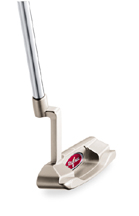 |
| Daytona Sport |
Tom Olsavsky, Taylor Made's Director of Product Marketing and Tour Engineering, served a major role in developing Rossa, and he says the company selected the color and name to audaciously announce its arrival: "We've noticed over the past several years that the most successful putter brands out there are sort of 'sub-brands' of the main company (such as Scotty Cameron of Titleist, and Odyssey of Callway), so we thought we'd be able to achieve more distinction for our new putter lines if we brought them out with their own identity."
"We wanted to create a brand name and put the technology behind it to focus back on the core Taylor Made buyer -- the better player, the key golfer or core golfer who uses a high-end product, but also one from Taylor Made. Someone who's looking to buy the best equipment he can find. Traditionally, Taylor Made has not been strong in putters, being more renowned for the best in metal wood products. With Rossa, we're aiming to change people's impressions," Olsavsky said.
For Rossa, it's more than just the bold look or sleek sounding moniker. There's science in the formulation. Again, Olsavsky explains: "The red material you see, both in the face and in the back cavity -- is a Titallium insert. It reduces the weight you'd normally put in those areas with an all-steel putter. We're able to take about 35 grams of weight out of the center, and up high, and move it to the extremes and also down low. It provides more forgiveness when you move the weight to the extremes, and down low."
"It makes for a better rolling putt when the weight's properly distributed. Moving the center of gravity back helps reduce the spin on the putt, and gets the ball rolling quicker. You wouldn't necessarily notice it when you're putting, but trust me, the faster you get the ball on the ground, the better off you'll be," Olsavsky added.
Anyone who's bounced a few putts after initially striking them knows exactly what he's talking about. What better way to send a putt off-line than putting it airborne -- which virtually guarantees a missed opportunity and added stroke to the scorecard.
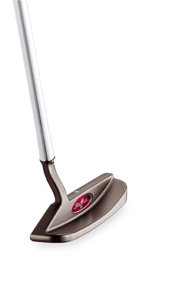 |
| Imola Tour |
The new technology was also in response to feedback from Tour players on the differences in putting with solid core golf balls, which virtually everyone plays these days. Olsavsky explains, "With the emergence of the newer multilayer balls last year, tour players commented to us that they felt a bit firm off of the putter face. Therefore we designed the Titallium insert to provide a softer feel than comparable metal putter faces, to help give players the proper impact sound. The 'feel' that most players refer to is mostly determined by the sound of impact. Players use this sound/feel to judge their distance control when putting. Poor sound feedback will eventually lead to poor putting over time."
Taylor Made claims it's also created a better mousetrap for manufacturing the Rossa line. "If you look at the precise manufacturing technology we use in terms of machining the product, the computer design properties, and the shapes of the putter heads -- we think they're the best shaped putters on the market and will compete with anything out there," said Olsavsky.
And Rossa did compete on tour in 2002. With 14 victories worldwide, it's been an eye-opening introduction for Taylor Made on the greens. But there are goals to satisfy in numbers counts on the various professional tours, too.
Olsavsky says it's their aim to be #2 next year (behind Titleist's Scotty Cameron line, the leader worldwide): "In 2002, on the PGA Tour we averaged 16 putters in play all year, with a high of 36 at one event. There were several weeks where we were in the #2 position in the count, ahead of Odyssey (Callaway's premium line)."
"One of our goals for 2003 is to reach the #2 position overall on the PGA Tour, and we think we've got the products and the range to do that. And seeing as Taylor Made is the number one played driver on tour, as well as the overall number one irons manufacturer on tour (a little known fact), we believe that's a good foundation for introducing Rossa to our regular players -- to show them the technology and gain support from guys already playing our equipment," Olsavsky said.
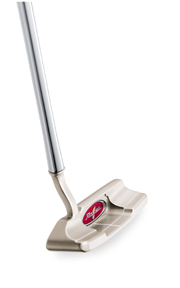 |
| Indy Sport |
He continues, "If you look at the putter business and where it's been driven in the past, it's by success on the professional tours. So we think we've done very well in that respect this year, and it's one of our strengths."
Unquestionably. But there were some other trends driving the formulation of a wide variety of Rossa models. Olsavsky speaks: "We've noticed, both on the PGA Tour and with players -- the trend is moving back towards 'mallet' styles of putter heads, whereas before that, it was more in the blade, heel-toe weighted styles. And when we launched the Rossa line, we thought we needed to bring out a few more 'mallet' models to help the line do a little better, and apply to more players."
"We also learned there were more players needing face-balanced (face-balanced means the shaft axis runs through the centerline) putters than we figured on initially. That's where the 'mallet' styles came in handy (like the Fontana and Maranello models). We've also launched a few other 'hybrid' models, which are kind of like half-blade, half-mallet (such as the Barcelona).
Finally, we've got some belly or mid-length models to appeal to players who prefer those types. We've sought to cover the full-range of preferences," Olsavsky added.
I personally tried out the Fontana 7 model in the Sport line.* Immediately I noticed the difference in shape and weight from the Scotty Cameron blade I've been using for the past couple seasons. The Fontana 7 is a 'mallet' style as Olsavsky described above, and I really liked the way the lines on the putter helped line-up my putts. The head was also considerably heavier, which required some adjustment.
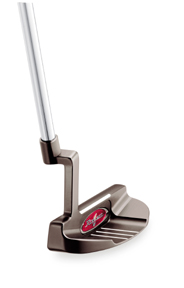 |
| Maranello Tour |
Upon using the putter for several rounds and a few trips to the practice green, I've found the heavier head helps me garner the proper speed for putts, and I left fewer putts short. True to Olsavsky's word, the Titallium insert has a soft feel, and the 'sound' of putts is pleasing and informative. Because I left fewer putts short, I'd say I three-putted a bit less than before.
I don't plan on abandoning my old Cameron blade, but just like you'd use different sand wedges for different types of playing conditions, I'll use the two putters for different types of greens. The Rossa putter is an excellent addition to my club arsenal, one that'll help me score better on courses with large greens or slow to medium rolling speeds -- because it's very effective in lag putting. Having tried many brands and styles over the years, the Rossa putter's looks and feel competes favorably with the top-of-the-line models from the best manufacturers.
Before purchasing a high-end putter (which can be quite an investment), I'd recommend trying it on real putting greens, from different lengths and breaks. How else to determine what's right for you? It's very possible you'll prefer one head style over another, or shaft length over a different one.
One other thing the Rossa line offers -- a tremendous selection of heads and shaft lengths. One of them will certainly fit your preferences. And the pro shop staff at your better clubs should be more than willing to let you try them all at once, so you can really 'feel' the differences.
Once you've found what you're looking for, take it out on the course. Rossa's bright red presence will set you apart from your partners -- and so will making more putts.
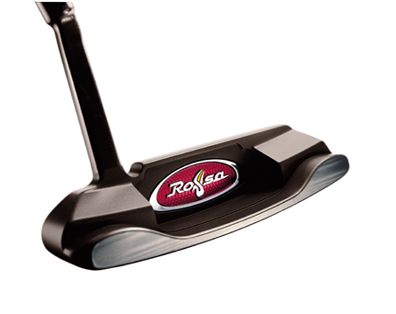 |
| Rossa (back) |
*Note: Rossa putters are available in two lines, the Sport and Tour. Differences in Sport and Tour lines: The Sport is a cast putter that's milled on the critical surfaces, while the Tour is a forged, carbon-steel putter that's 100% milled.
Details:
Rossa Putters, by
Series Designer: Tom Olsavsky
Available at Fine Pro Shops and Retail Stores
The Rossa Website: www.RossaPutters.com
Check out all of Taylor Made's Fine Products at: Taylor Made's Website
| Related Links | Comments on this article? | |
|
Maryland National Golf Club Hollow Creek Golf Club Rocky Gap Resort PB Dye Golf Club in Ijamsville Whiskey Creek Golf Club |
E-mail Jeff Rendall, Editor: jrendall@golftheunitedstates.com |












